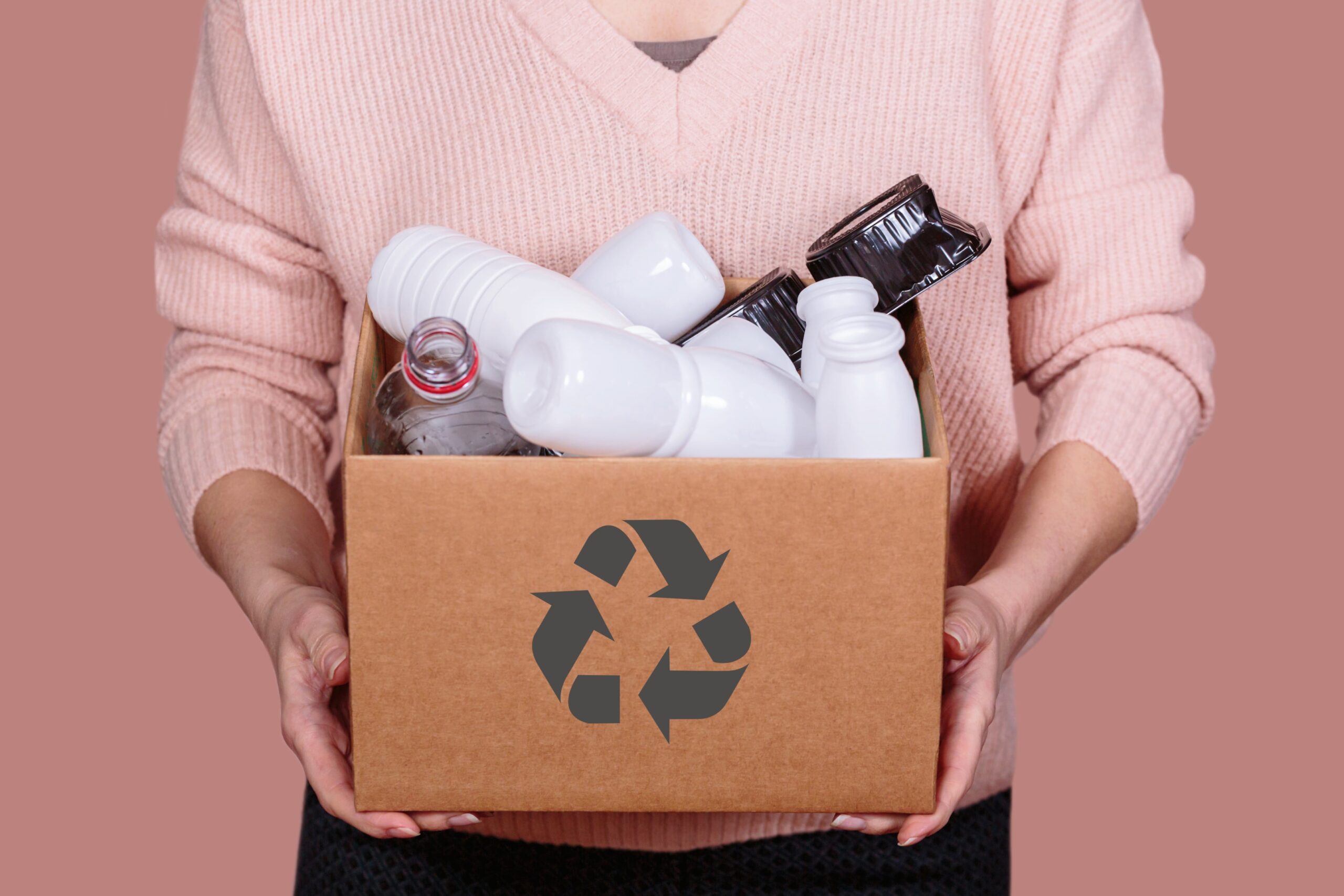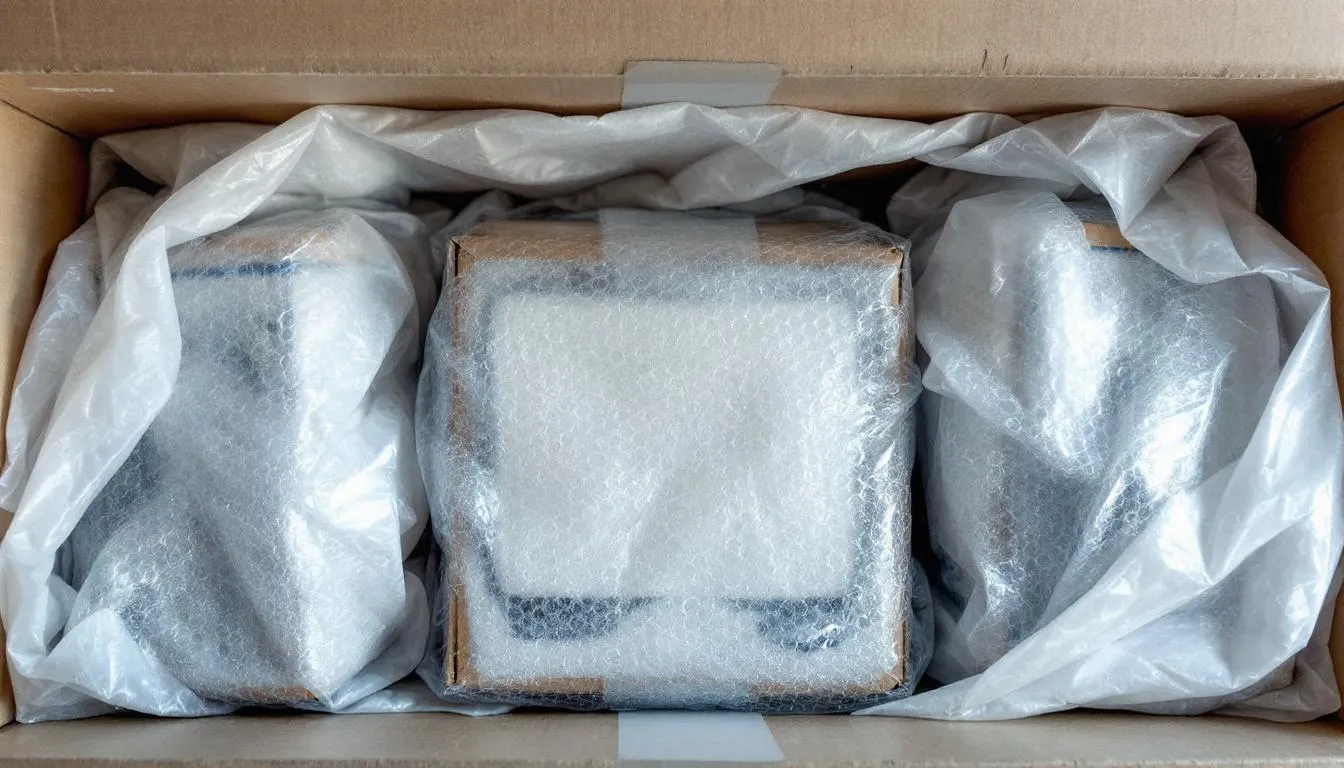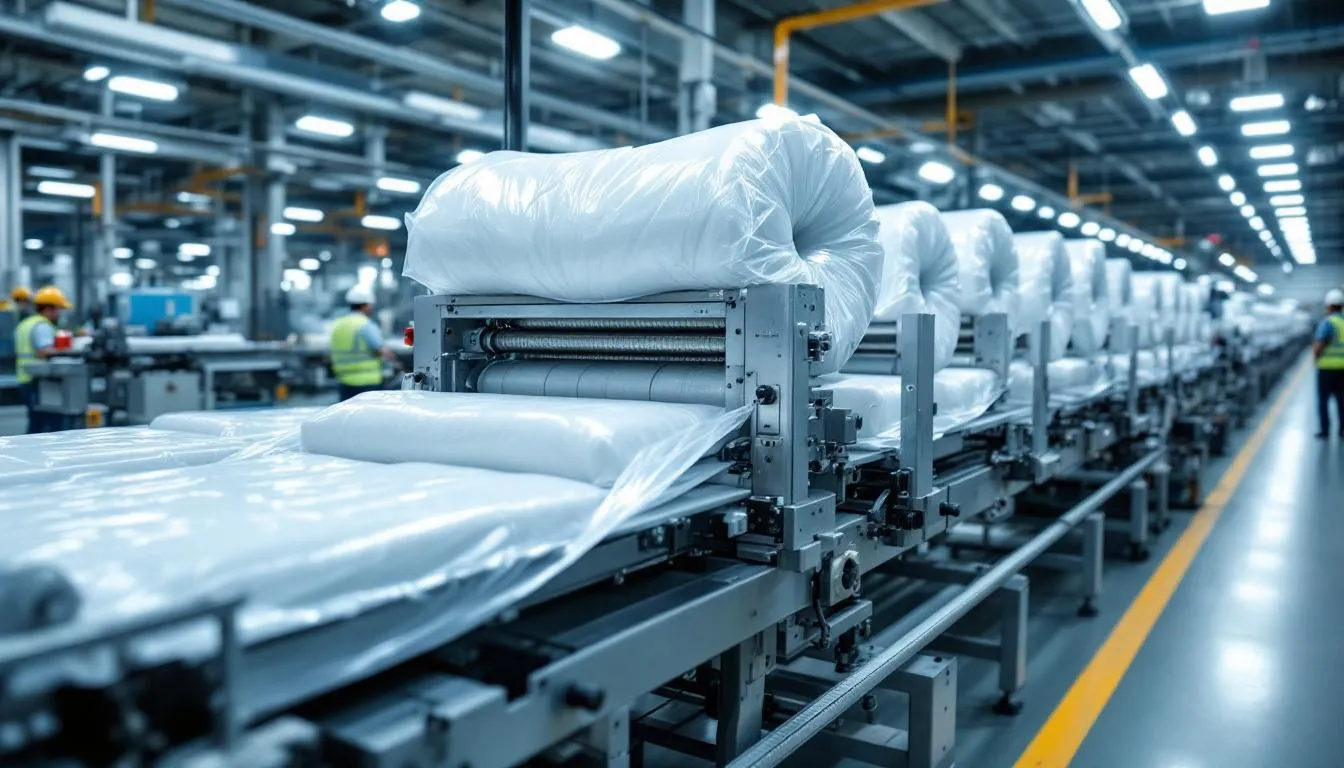The packaging industry stands at a critical juncture. With 73% of consumers more likely to purchase from brands using sustainable packaging, and mounting regulatory pressure worldwide, eco-friendly packages have shifted from optional green initiatives to essential business strategy. Yet many logistics managers and corporate buyers struggle to navigate the complex landscape of sustainable packaging options while maintaining operational efficiency and cost control.
Adopting eco-friendly packages aligns with a company’s mission to create a positive environmental impact, demonstrating a commitment to sustainability and responsible business practices.
This comprehensive guide cuts through the complexity to deliver actionable insights for business decision-makers ready to implement eco-friendly packaging solutions. From biodegradable materials to automated sustainable systems, we’ll explore proven strategies that reduce environmental impact while protecting your bottom line. Discover the difference eco-friendly packages can make for both your business and the environment.
What Are Eco-Friendly Packages and Why Do They Matter
Eco friendly packages are made from renewable, recycled, or biodegradable materials designed to minimize environmental impact throughout their entire lifecycle—from sourcing and manufacturing to use and disposal. Biodegradable packaging, in particular, is a key sustainable option, offering compostability and environmental benefits as part of innovative, eco-friendly solutions. Unlike traditional packaging that relies heavily on virgin plastics and non-recyclable materials, sustainable packaging options prioritize resource conservation and waste reduction.
The business case for eco-friendly packaging extends far beyond environmental responsibility. Companies implementing sustainable packaging solutions report improved brand loyalty, regulatory compliance advantages, and often reduced long-term costs through material efficiency and waste elimination strategies. Incorporating eco-friendly labels alongside sustainable packaging materials is also essential, as compostable and environmentally conscious labels contribute to a comprehensive sustainable packaging strategy.
Key drivers pushing businesses toward eco-friendly materials include:
Regulatory compliance: EU plastic bans and state-level legislation requiring sustainable packaging
Consumer demand: Growing preference for environmentally responsible brands
Cost optimization: Reduced waste management fees and material efficiency gains
Risk mitigation: Protection against future regulatory changes and supply chain disruptions
Companies like Ritual, Stio, and Amazon have successfully adopted eco-friendly packaging to meet consumer demands while maintaining operational excellence. These implementations demonstrate that sustainable packaging supports both environmental goals and business growth.
Types of Sustainable Packaging Materials
Understanding the landscape of eco-friendly packaging options enables informed decision-making that balances performance requirements with sustainability goals. Many eco-friendly packaging materials are derived from plants, offering renewable and sustainable options. Modern sustainable materials offer diverse solutions for virtually every packaging application. Sustainable shipping supplies are now widely available to support businesses’ eco-friendly goals.
Recycled and Recyclable Options
100% Recycled Corrugated Cardboard Available from suppliers like Pratt and Amazon, recycled cardboard boxes provide robust protection while supporting circular economy principles. These boxes are often sold in convenient packs, making it easier for businesses to purchase the quantities they need. They maintain structural integrity comparable to virgin materials while reducing demand for new forestry resources.
Recycled Padded Mailers Featuring 20-30% post-consumer waste content, recycled padded mailers deliver cushioned protection for shipping while maintaining full recyclability in standard waste streams. These mailers offer cost-effective alternatives to traditional plastic bubble mailers.
Paper Padded Mailers Combining paper construction with internal cushioning, these mailers provide product protection while remaining fully recyclable through standard paper recycling programs. They eliminate the separation requirements of mixed-material packaging.
Molded Fiber Containers Manufactured from recycled paper pulp, molded fiber packaging offers customizable shapes for specific product protection needs. These containers provide excellent cushioning properties while maintaining complete recyclability and compostability.
Compostable and Biodegradable Solutions
PLA-Based Packaging Polylactic acid packaging derived from corn or sugarcane biodegrades in commercial composting facilities under proper conditions within 90-180 days. While requiring specific disposal infrastructure, PLA offers plastic-like performance for many applications.
Home Compostable Mailing Satchels Certified to break down in backyard compost bins, these mailers provide the ultimate in end-of-life convenience for consumers. They eliminate disposal concerns while maintaining shipping durability.
Certified Compostable Food Pouches Featuring high barrier coatings for freshness protection, compostable food packaging maintains product quality while ensuring complete biodegradation in industrial composting facilities.
Plant-Based Poly Bags and Mailers: Serving as direct replacements for traditional plastic packaging, plant-based alternatives offer familiar functionality while supporting biodegradable disposal options.
Innovative Materials Leading the Future
Seaweed-Based Packaging Utilizing agar extracted from algae, seaweed packaging represents abundant, renewable resources capable of replacing petroleum-based plastics for food and single-use applications. Early partnerships are positioning seaweed as a breakthrough solution for flexible packaging needs.
Mushroom Packaging Manufactured from mycelium combined with agricultural waste, mushroom packaging provides custom-molded protection for products during transit. This fully biodegradable material offers excellent cushioning properties for electronics and fragile items.
Ocean-Bound Plastic Solutions Technologies like POLLAST!C transform ocean-bound plastics into new packaging materials, addressing pollution while creating functional packaging solutions. This approach combines waste reduction with practical material sourcing.
Eco-Friendly Coffee Packaging Innovative materials are now being used to create sustainable packaging solutions specifically for coffee products. These eco-friendly options, such as compostable films and recyclable paper-based bags, are designed to appeal to environmentally conscious coffee brands and consumers seeking greener alternatives for their packaging needs.
Benefits of Sustainable Packaging
Adopting sustainable packaging delivers a wide range of benefits for both businesses and the environment. By choosing eco-friendly packaging solutions, companies can significantly reduce their carbon footprint and eliminate waste throughout their supply chain. Utilizing biodegradable materials, recyclable boxes, and compostable bags helps minimize environmental impact, supporting a healthier planet for future generations.
Sustainable packaging options also offer a competitive edge in today’s market. Customers are increasingly drawn to brands that demonstrate a commitment to eco-friendly practices, and using the right packaging can enhance your brand’s reputation and foster customer loyalty. Businesses can explore a variety of packaging solutions, such as padded mailers, recyclable boxes, and biodegradable bags, to find the most effective and sustainable fit for their products.
Beyond environmental benefits, sustainable packaging can streamline operations by reducing waste and optimizing material usage. Companies that make the switch to eco-friendly packaging not only contribute to a greener future but also position themselves as leaders in promoting sustainability within their industry. By exploring innovative packaging options and integrating them into your business model, you can support environmentally responsible practices while meeting the evolving expectations of your customers.
Inner Packaging Solutions for Businesses
Inner packaging is a vital component of any packaging strategy, ensuring that products remain protected during shipping and storage. Businesses can make a positive environmental impact by selecting eco-friendly inner packaging materials such as tissue paper, recyclable inserts, and biodegradable fillers. These sustainable materials help reduce waste and lower the overall carbon footprint of your packaging operations.
Choosing the right inner packaging solutions allows companies to maintain product integrity while supporting their sustainability goals. Options like custom boxes, padded envelopes, and reusable bags can be tailored to meet specific business needs, offering both protection and a positive brand experience. By integrating recyclable and biodegradable materials into your inner packaging, you demonstrate a commitment to environmentally responsible practices that resonate with customers.
Exploring a variety of eco-friendly inner packaging options enables businesses to find solutions that align with their brand values and product requirements. Whether you’re shipping delicate items or bulk goods, sustainable inner packaging ensures your products are well-protected and your company is contributing to a more sustainable future.
Industry Applications and Success Stories
Real-world implementations demonstrate the practical viability of eco-friendly packaging across diverse industries. For example, sustainable packaging solutions are specifically designed to protect garments and apparel, supporting eco-friendly practices in the fashion industry. These examples provide actionable insights for businesses considering sustainable packaging transitions.
eCommerce Success Stories
Ritual’s Recycled Approach The nutrition company Ritual utilizes 100% recycled padded mailers to meet sustainability goals while maintaining product protection standards. Their implementation demonstrates that eco-friendly packaging options can deliver operational efficiency without compromising customer experience.
Keap’s Mushroom Innovation Skincare brand Keap employs mushroom packaging for product protection, showcasing how innovative sustainable materials can enhance brand differentiation while providing superior cushioning properties.
Industry-Specific Applications
Apparel Companies Leading clothing brands increasingly choose branded boxes and poly mailers with high post-consumer content, reducing virgin material consumption while maintaining brand presentation standards. Custom printing on recycled materials enables brand consistency without environmental compromise.
Food Service Operations Restaurants and food service businesses adopt compostable containers and packaging for takeout orders, addressing mounting single-use waste concerns while meeting customer expectations for environmental responsibility.
Cannabis Industry Innovation Cannabis businesses utilize eco-friendly pouches and bags for product protection and regulatory compliance, demonstrating how specialized industries can integrate sustainable packaging into complex operational requirements.
Cost-Effective Implementation Strategies
Sustainable packaging implementation requires strategic planning that balances environmental goals with operational realities. Modern suppliers have developed accessible approaches that accommodate businesses of all sizes. Shop for eco-friendly packaging products from reputable suppliers to support your sustainability goals.
Wholesale Pricing and Accessibility
Wholesale prices make sustainable packaging accessible for businesses of all sizes, with many suppliers offering competitive pricing that rivals traditional packaging costs. This accessibility removes cost barriers that previously limited sustainable packaging adoption.
Minimum Order Flexibility Many suppliers now offer minimum order quantities as low as one case, enabling small businesses to test eco-friendly packaging options without significant upfront investment. This approach supports gradual transition strategies and pilot program development.
Shipping Cost Optimization Free shipping offers on orders over $1,000 from suppliers like EnviroPackaging reduce total acquisition costs while encouraging larger orders that improve per-unit economics.
Custom Branding Without Premium Pricing
In-House Printing Capabilities Custom printing available on recycled kraft mailers, poly bags, and corrugated boxes enables brand consistency without premium pricing. In-house printing capabilities provide quick turnaround times while maintaining cost efficiency.
All-Over Printing Options Unique design capabilities enhance customer unboxing experiences while supporting brand differentiation. These custom options demonstrate that sustainable packaging can enhance rather than compromise brand presentation. Custom sustainable packaging can also elevate your brand’s image and customer experience, helping your business stand out and communicate eco-conscious values.
Single-Case Minimums for Customization Starting quantities of single cases for custom branding enable cost-effective brand customization for businesses testing sustainable packaging approaches.
Choosing the Right Eco-Friendly Package for Your Business
Successful sustainable packaging selection requires a systematic evaluation of multiple factors that impact both environmental outcomes and business operations. Adopting greener practices when selecting eco-friendly packaging solutions is essential for integrating sustainability seamlessly into your business. This structured approach ensures optimal material selection for specific applications.
Performance and Protection Requirements
Evaluate material capabilities against specific shipping distances, handling requirements, and product protection needs. Consider environmental conditions during transit and storage that may affect packaging performance.
Certification Verification Look for materials with BPI (Biodegradable Products Institute) compostable certification, FSC (Forest Stewardship Council) certification, or verified recycled content percentages. These third-party certifications ensure materials meet claimed performance standards.
Customer Experience Integration: Consider unboxing experience implications and brand image alignment when selecting sustainable packaging. The right packaging enhances brand perception while supporting environmental goals.
Operational Compatibility Assessment
Automation Compatibility: Evaluate material compatibility with existing automated packaging lines or manual fulfillment processes. Some eco-friendly materials require specific handling considerations that may affect operational efficiency.
Supply Chain Integration Assess supplier reliability, lead times, and geographic coverage to ensure sustainable packaging doesn’t disrupt existing fulfillment operations. Consider backup supplier options for critical packaging components.
Quality Assurance Protocols: Test sustainable packaging samples before committing to full orders to ensure quality meets operational standards. Document performance requirements and establish quality benchmarks for ongoing supplier evaluation.
Cost-Benefit Analysis Framework
Balance upfront material costs against potential savings in waste management, customer loyalty improvements, and regulatory compliance benefits. Consider total lifecycle costs rather than just initial material expenses.
Implementation Timeline Planning: Develop phased implementation strategies that allow gradual transition while maintaining operational continuity. Consider seasonal demand patterns and inventory management requirements.
ROI Measurement Systems Establish metrics for measuring sustainable packaging ROI, including waste reduction, customer satisfaction improvements, and potential cost savings over time.
Overcoming Challenges in Sustainable Packaging
Transitioning to sustainable packaging can present challenges, but businesses have more resources and options than ever to overcome them. One common hurdle is sourcing affordable, high-quality eco eco-friendly packaging solutions. Fortunately, many suppliers now offer wholesale prices on sustainable packaging supplies, making it easier for companies of all sizes to access eco-friendly materials without straining their budgets.
Ensuring that sustainable packaging meets performance and quality standards is another key concern. Businesses can address this by partnering with reputable suppliers who provide certified compostable, biodegradable, or recyclable materials. This guarantees that your packaging solutions are both effective and environmentally responsible.
Innovation is also driving the market forward, with new materials like algae ink and plant-based packaging offering exciting alternatives to traditional options. By staying informed and open to exploring these innovations, companies can meet customer demand for sustainable packaging and maintain a competitive edge. Commitment to sustainability, combined with a willingness to explore new solutions, enables businesses to successfully implement eco friendly packaging practices and achieve their environmental goals.
Future Innovations in Sustainable Packaging
The sustainable packaging landscape continues evolving rapidly, with breakthrough innovations promising even more effective eco eco-friendly packaging solutions. Understanding emerging trends enables strategic planning for future packaging needs.
Next-Generation Materials
Seaweed-Based Partnerships Collaborative developments in seaweed-based packaging offer ocean-derived alternatives to petroleum-based plastics. These partnerships position seaweed as a scalable solution for flexible films and rigid containers.
Sugarcane-Based Innovations Bagasse (sugarcane residue) repurposing creates compostable, durable mailers as renewable alternatives to traditional shipping materials. This agricultural waste utilization supports circular economy principles while providing functional packaging solutions.
Zero-Waste Packaging Systems
Circular Economy Integration: Growing interest in systems that eliminate waste by ensuring all packaging components are either returned, reused, or composted drives innovation toward fully circular packaging approaches.
Automated Sustainable Solutions Integration of sustainable materials with automated packaging systems reduces labor costs while ensuring consistent application of eco-friendly packaging options throughout fulfillment operations.
Technology-Enabled Sustainability
Algae Ink Applications Development of algae ink for printing applications reduces petroleum-based ink consumption while maintaining print quality standards. This innovation supports comprehensive sustainability approaches across all packaging components.
Smart Packaging Integration Connected packaging technologies that optimize material usage and provide end-of-life guidance enhance the effectiveness of sustainable packaging implementations.
Implementation Roadmap for Business Success
Successful sustainable packaging implementation requires structured planning that addresses operational, financial, and environmental objectives simultaneously. This roadmap provides actionable steps for businesses ready to transition to eco-friendly packages.
Phase 1: Assessment and Planning
Conduct comprehensive packaging audits to identify current material usage, waste streams, and cost structures. Establish baseline metrics for measuring improvement and ROI from sustainable packaging initiatives.
Stakeholder Alignment: Engage key stakeholders, including operations, procurement, marketing, and sustainability team,s to ensure comprehensive planning that addresses all operational requirements.
Supplier Research and Evaluation Research suppliers offering eco-friendly packaging solutions with appropriate certifications, quality standards, and delivery capabilities. Request free samples to evaluate material performance and customer experience implications.
Phase 2: Pilot Program Development
Launch limited pilot programs with selected sustainable packaging options to test performance, customer response, and operational integration. Document results and refine selection criteria based on real-world performance data.
Performance Monitoring: Establish monitoring systems for tracking packaging performance, cost impacts, and environmental benefits during pilot phases. Use data to optimize material selection and implementation processes.
Phase 3: Scaled Implementation
Roll out successfu,l sustainable packaging solutions across broader operations while maintaining quality standards and operational efficiency. Continue monitoring and optimization to maximize both environmental and business benefits.
Additional Resources for Sustainable Packaging
Businesses seeking to enhance their sustainable packaging practices have access to a wealth of resources and support. Online platforms, industry reports, and expert advice offer valuable insights into the latest eco-friendly packaging options and best practices. Many suppliers provide free samples and consultations, helping companies find the right packaging solutions tailored to their needs.
Certifications and organizations, such as the Biodegradable Products Institute (BPI), offer guidance on selecting and verifying sustainable packaging materials. Networking with other businesses and industry experts through events and online forums can also provide practical knowledge and inspiration for your sustainability journey.
To stay ahead of the curve, companies can explore packaging guides, webinars, and workshops that deliver hands-on training and up-to-date information on innovations in sustainable packaging. By leveraging these resources, businesses can make informed decisions, connect with trusted suppliers, and continuously improve their packaging strategies to support both environmental and business objectives.
Conclusion
The transition to eco-friendly packages represents both environmental necessity and strategic business opportunity. Companies implementing sustainable packaging solutions position themselves advantageously for regulatory compliance, customer loyalty, and operational efficiency while contributing meaningfully to environmental protection.
Success requires systematic evaluation of materials, suppliers, and implementation strategies that balance environmental goals with operational realities. The growing accessibility of wholesale prices, reduced minimum orders, and custom branding options eliminates traditional barriers to sustainable packaging adoption.
Forward-thinking businesses that strategically invest in validated eco-friendly packaging solutions today will capture market advantages while building foundations for long-term sustainability success. The combination of regulatory trends, consumer preferences, and material innovations makes sustainable packaging not just environmentally responsible, but competitively essential.
Ready to transform your packaging strategy with automated, sustainable solutions? Contact AirFill Technologies today to explore how our innovative approaches to eco-friendly packages can reduce your environmental impact while optimizing operations and enhancing customer experience. Our team specializes in implementing sustainable packaging solutions that deliver measurable results for businesses committed to promoting sustainability without compromising operational excellence.



